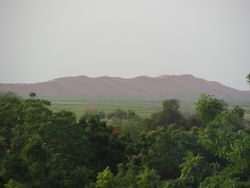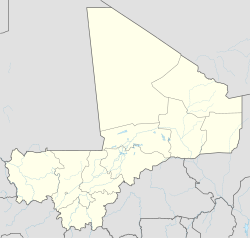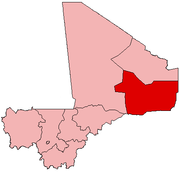گاو
گاو
Gao | |
|---|---|
كميون حضري وبلدة | |
 الكثبان الوردية ومدينة گاو كما تبدو من ضريح أسكيا. | |
موقع گاو في مالي | |
| الإحداثيات: 16°16′N 0°03′W / 16.267°N 0.050°W | |
| البلد | |
| المنطقة | گاو |
| الدائرة | دائرة گاو |
| المنسوب | 226 m (744 ft) |
| التعداد (2009)[1] | |
| • الإجمالي | 86٬633 |
| منطقة التوقيت | UTC+0 (GMT) |
گاو Gao، هي بلدة شرق مالي على نهر النيجر وتقع على بعد 320 كم من العاصمة تيمبكتو. وتقع المدينة على الضفة اليسرى للنهر عند تقاطعه مع وادي تيلمسي، وهي عاصمة منطقة گاو، ووصل عدد سكانها إلى 86,663 في 2009.
For much of its history Gao was an important commercial centre involved in the trans-Saharan trade. In the 9th century external Arabic writers described Gao as an important regional power,[2] and by the end of the 10th century, the local ruler was said to be a Muslim. Towards the end of the 13th century Gao became part of the Mali Empire, but in first half of the 15th century the town regained its independence and with the conquests of Sunni Ali (ruled 1464–1492) it became the capital of the Songhai Empire. The Empire collapsed after the Moroccan invasion in 1591 and the invaders chose to make Timbuktu their capital. By the time of Heinrich Barth's visit in 1854, Gao had declined to become an impoverished village with 300 huts constructed from matting. In 2009, the urban commune had a population of 86,633.
في 31 مارس 2012، سقطت گاو من سيطرة قوات الحكومة المالية في أيدي متمردي الحركة الوطنية لتحرير أزواد وأنصار الدين. After the additional captures of Kidal and Timbuktu, on 6 April, the MNLA declared the region independent of Mali as the nation of Azawad[3] and named Gao its capital.[4] The MNLA lost control to Islamist militias after the Battle of Gao on 26 and 27 June 2012. On 26 January 2013, the city was recaptured by French military forces as part of Opération Serval.[5]
الجغرافيا
الموقع
المناخ
| گاو، مالي | ||||||||||||||||||||||||||||||||||||||||||||||||||||||||||||
|---|---|---|---|---|---|---|---|---|---|---|---|---|---|---|---|---|---|---|---|---|---|---|---|---|---|---|---|---|---|---|---|---|---|---|---|---|---|---|---|---|---|---|---|---|---|---|---|---|---|---|---|---|---|---|---|---|---|---|---|---|
| جدول طقس (التفسير) | ||||||||||||||||||||||||||||||||||||||||||||||||||||||||||||
| ||||||||||||||||||||||||||||||||||||||||||||||||||||||||||||
| ||||||||||||||||||||||||||||||||||||||||||||||||||||||||||||
الفيضان السنوي لنهر النيجر
التاريخ
| ضريح أسكيا | |
|---|---|
 | |
| أسس الاختيار | ثقافي: ii, iii, iv |
| المراجع | 1139 |
| Inscription | 2004 (28 Session) |
الثقافة
أهم المعالم
- مسجد گاو
- ضريح أسكيا، موقع تراث عالمي
- الكثبان الوردية
- sand dune
مدن شقيقة
گاو مدينة شقيقة لمدينة Thionville، فرنسا، وبركلي، كاليفورنيا، الولايات المتحدة.
هوامش
- ^ Resultats Provisoires RGPH 2009 (Région de Gao), République de Mali: Institut National de la Statistique, http://instat.gov.ml/documentation/gao.pdf
- ^ Levtzion 1973, p. 3.
- ^ "Tuareg rebels declare the independence of Azawad, north of Mali". Al Arabiya. 6 April 2012. Retrieved 6 April 2012.
- ^ "Tuaregs claim 'independence' from Mali". Al Jazeera. 6 April 2012. Retrieved 6 April 2012.
- ^ Mali: French-led soldiers 'in control of Gao', 26 January 2013, https://www.bbc.co.uk/news/world-africa-21210496, retrieved on 26 January 2013.
المصادر
- Barth, Heinrich (1859), Travels and discoveries in North and Central Africa: Being a journal of an expedition undertaken under the auspices of H.B.M.'s government, in the years 1849–1855 (Volume 3), New York: Harper & Brothers, http://books.google.co.uk/books?id=l74ZAAAAYAAJ.
- Hunwick, John (1994), "Gao and the Almoravids revisited: ethnicity, political change and the limits of interpretation", Journal of African History 35: 251–273.
- Hunwick, John O. (2003), Timbuktu and the Songhay Empire: Al-Sadi's Tarikh al-Sudan down to 1613 and other contemporary documents, Leiden: Brill, ISBN 0585-6914. First published in 1999 as ISBN 9004112073.
- Insoll, Timothy (1997), "Iron age Gao: an archaeological contribution", Journal of African History 38: 1–30, http://www.insoll.org/Iron%20Age%20Gao.pdf.
- Kâti, Mahmoûd Kâti ben el-Hâdj el-Motaouakkel (1913) (in French), Tarikh el-fettach ou Chronique du chercheur, pour servir à l'histoire des villes, des armées et des principaux personnages du Tekrour, Houdas, O., Delafosse, M. ed. and trans., Paris: Ernest Leroux, http://gallica.bnf.fr/ark:/12148/bpt6k5439466q. Also available from Aluka but requires subscription.
- Lange, Dierk (1991), "Les rois de Gao-Sané et les Almoravides" (in French), Journal of African History 32: 251–275.
- Lange, Dierk (1994), "From Mande to Songhay: Towards a political and ethnic history of medieval Gao", Journal of African History 35: 275–301.
- Levtzion, Nehemia (1973), Ancient Ghana and Mali, London: Methuen, ISBN 0841904316.
- Levtzion, Nehemia; Hopkins, John F.P., eds. (2000), Corpus of Early Arabic Sources for West Africa, New York, NY: Marcus Weiner Press, ISBN 1-55876-241-8. First published in 1981 by Cambridge University Press, ISBN 0521224225.
- Moraes Farias, Paulo F. de (1990), "The oldest extant writing of West Africa: medieval epigraphs from Essuk, Saney, and Egef-n-Tawaqqast (Mali)", Journal des Africanistes 60: 65–113, http://www.persee.fr/web/revues/home/prescript/article/jafr_0399-0346_1990_num_60_2_2452. Link is to a scan on the Persée database that omits some photographs of the epigraphs.
- Sauvaget, J. (1950), "Les épitaphes royales de Gao", Bulletin de l'Ifan XII (2): 418–440. A reprint of (1949), Al-Andalus XIV: I, 123–141.
قراءات إضافية
- Cornevin, R. (1991), "Gao", Encyclopaedia of Islam Volume 2 (2nd ed.), Leiden: Brill, pp. 976–978, ISBN 9004070265, http://www.archive.org/stream/EncyclopediaofIslam2/Vol.2c-g#page/n1017/mode/1up. First published in 1965.
- Mauny, Raymond (1951), "Notes d'archéologie au sujet de Gao" (in French), Bulletin de l'Institut Français d'Afrique Noire (B) 13: 837–852.
- Moraes Farias, P.F. de (2003), Arabic medieval inscriptions from the Republic of Mali : Epigraphy, chronicles and Songhay-Tuareg history, Oxford: Oxford University Press, ISBN 0197262228.
وصلات خارجية
- Tomb of Askia, UNESCO World Heritage, http://whc.unesco.org/en/list/1139.
- Pages using gadget WikiMiniAtlas
- Short description is different from Wikidata
- Pages using infobox UNESCO World Heritage Site with unknown parameters
- Coordinates on Wikidata
- أماكن مأهولة في منطقة گاو
- عواصم مناطق مالي
- تاريخ مالي
- إمبراطورية مالي
- إمبراطورية صنغاي
- غرب أفريقيا الفرنسي
- تجمعات على نهر النيجر
- منطقة گاو


